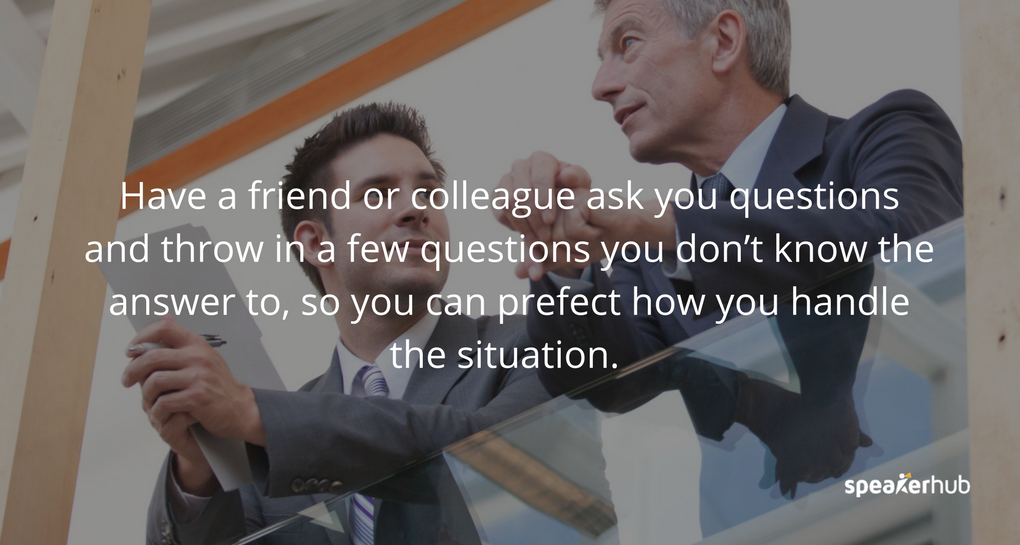Q+As: What to do when you don’t know the A

We’ve all been there.
Whether it was during a presentation on stage, or during a conversation with a friend, there has probably been one point where you simply had no clue how to the answer the question.
During a conversation with a friend admitting you don’t know the answer is not an issue, but up on stage it’s quite a different story.
You might feel flustered or embarrassed and resort to making up an impromptu answer, or standing there stammering unprofessionally - potentially losing the confidence of your audience.
Here are some tools you can use to handle the situation flawlessly.
Set yourself up for success
Before you even get to the event, there are a few things you can do to safeguard yourself from getting into an awkward situation.
Presentation expert Nancy Duarte wrote up an excellent article for excelling at presentation Q&As, and her advice for preparing is simple:
- Decide when and how you want to take questions during your talk
- Brainstorm every potential question the audience might ask
- Rehearse answers with others in a safe environment
Collect questions beforehand
Collecting the audience’s questions before the event can help on multiple levels: you can plan your talk to address the audience’s needs, and the audience will have the time to properly think about what they need instead of trying to come up with questions at the end of your presentation.
There are a handful of online tools and apps that make this easier, or you can run a pre-event survey to find out what questions the audience will come to the event with.
When you are gathering questions, give the audience direction by stating the focus of the Q & A.

You can also say that you’re going to start the Q+A with some common questions. These should be questions you have either encountered in other presentations, or that you know will help the audience. This can help to get things moving along and break the ice.
Rehearse
Get better at Q+As by rehearsing with a friend, colleague or even the event organizer.

Have your practice partners ask you as many questions as possible, and throw in a few questions they are certain you don’t know the answer to, so you can prefect how you handle the situation professionally and smoothly.
You can also make a list of possible questions, and either practice them on your own, or have someone ask them to you.
This will give you the chance to practice giving clear, succinct answers.
It can happen, however, where you will still end up not knowing the answer, so what should you do? The next section of this article will cover how to control the situation when you don’t know the answer to a question.
What to do when “it” happens
First, think about your potential responses beforehand.
Have a prepared response up your sleeve for any difficult or even confrontational questions that might come up.
- “That’s a great question. I don’t think it’s appropriate for me to answer that from the stage, but I’ll happily discuss this with you in person after this session.”
- “It’s an insightful question and an issue that a few people might have, at the same time, I’d like to stay focused on [this topic] for the sake of the whole audience.”
The five steps below will help you appear calm, collected and confident on stage if you get a question you don’t know the answer to.
Step #1: Stay comfortable. Don’t get frazzled.
The most important thing initially is to stay calm.

Take a few deep breaths, and remind yourself that you are not expected to know the answers for everything, and that you can handle this situation.
Step #2: Take your time.
Acknowledge that the question was asked and tell the audience that you are thinking about it.
If the answer is just on the tip of your tongue, give yourself a few long seconds to think about it.

You can buy sometime by repeating the question yourself or ask the person to repeat and elaborate on it while you also gain a bit of time.
After you’ve taken a minute to gather your thoughts, try explaining succinctly what you’ve been thinking, and then move forward from there.
Step #3: Admit you don’t know.
Do not try and fake that you know the answer. Don’t make something up or try and distract the audience by rambling on and trying to obscure the fact you don’t know the answer. Focus on being honest, and credible.

How can you do this while still remaining professional?
Here is an example of how to respond. Take a moment to collect your thoughts, then answer:
“Thats a good question. To be perfectly honest, I don’t have an answer for you. But let me find out and get back to you. Let’s connect after the session and I will get your email address.”
This can be broken down into a few main parts.
- Acknowledge the question positively.
- Explain that you don’t know the answer in a clear and concise manner.
- Tell them you will find out for them.
- Clarify how you will get back to them.
- Give them a definite date/time.
Always follow up with them if you say you are going to. If you know you aren’t going to be able to get back to them, use a different tactic.
Step #4: Crowdsource by asking the audience
This technique is ideal for meeting the needs of the asker. Ask if anyone else in the audience knows the answer or can provide more insight.

For example, you could say:
"Great question. I never actually thought about that before, and I am not sure. I would like to turn this question on to the audience to find out if maybe someone else here knows the answer."
This can be especially effective if you already know someone in the audience has more knowledge or experience; you can suggest that perhaps they can tackle the question with more depth.
If someone from the audience is able to answer, make sure to thank them for their contribution.
If not, you can turn around and say, “Wow, you've stumped all of us! I am going to look into it and get back to you. I’ll post the answer on Twitter tomorrow for anyone who is interested."
Step #5: End with grace.
If you have time for more questions, don’t dwell for too long on what you don’t know and move on to the next question.
If you don’t have more time, end the session with a short summary of the new information discussed and where you can be reached.
Always be sure to thank the audience, and let them know that you are available for additional questions either online or after the session.

Remember: no one's perfect and expected to be a walking encyclopedia Don't worry whether or not you will get a question that will stump you. Be as prepared as possible, be confident in what you know, and use the techniques above to handle any questions you don’t.
Do you have other techniques you’d like to share with us? Get in touch and let us know!


